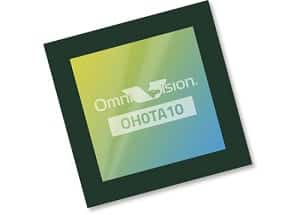New medical sensor for endoscope and catheter cameras improves image quality and reduces power consumption
 Allowing designers to add ultra-compact visualisation to single-use and reusable endoscopes, as well as catheters and guidewires, is the tiny new OH0TAOVMed medical image sensor. It also quadruples the RGB image resolution to 400 x 400, or 160 Kpixels, at 30 frames per second, while reducing the power consumption by 20 per cent to 20 mW.
Allowing designers to add ultra-compact visualisation to single-use and reusable endoscopes, as well as catheters and guidewires, is the tiny new OH0TAOVMed medical image sensor. It also quadruples the RGB image resolution to 400 x 400, or 160 Kpixels, at 30 frames per second, while reducing the power consumption by 20 per cent to 20 mW.
The sensor’s uniquely small size gives medical device OEMs the flexibility to create a larger-diameter scope with a larger working channel.
The OH0TA’s increased resolution allows higher quality colour images to be captured from within the body’s smallest organs, enabling medical devices to reach deeper into the body for procedures such as neuro, ophthalmic, ENT, cardiac, spinal, urology, gynaecology and arthroscopy, as well as dental and veterinary diagnosis and surgery. Additionally, the sensor’s lower power consumption reduces “chip on tip” camera heat for greater patient comfort and longer procedure durations, while also reducing noise for crisper images.
To achieve increased resolution along with smaller pixel size and optical format, the OH0TA is built on OmniVision’s PureCel Plus-S stacked die technology. This next-generation pixel technology provides higher colour fidelity and excellent low light sensitivity of 3600 mV/lux-sec, along with a high signal-to-noise ratio of 37.5 dB for crisper images. Additionally, PureCel Plus-S enables the OH0TA’s higher full well capacity (FWC), zero blooming and lower power consumption.
According to the market research and strategy consulting company Yole Développement (Yole), a 10.4 per cent CAGR is expected from 2020 to 2025, for the CMOS image sensor (CIS) industry. “Advanced node technology in CISs is bringing higher resolution and innovative stack processes help to optimise the performance as well as the module size,” commented Chenmeijing Liang, technology and market analyst, imaging at Yole. “These state-of-the-art CIS technologies are meeting today’s key endoscopy requirements to support doctors in their diagnostic processes or surgical procedures with higher image quality and better contrast while increasing patient comfort. They also allow less invasive imaging techniques for neurologic, ENT or pediatric applications without altering image resolution.”
Available in a package size of just 0.55 mm x 0.55 mm, samples of the OH0TA can be obtained now in OmniVision’s hCSP chip-scale package with 100-micron thick cover glass, an anti-reflective coating and 1/31” optical format.






